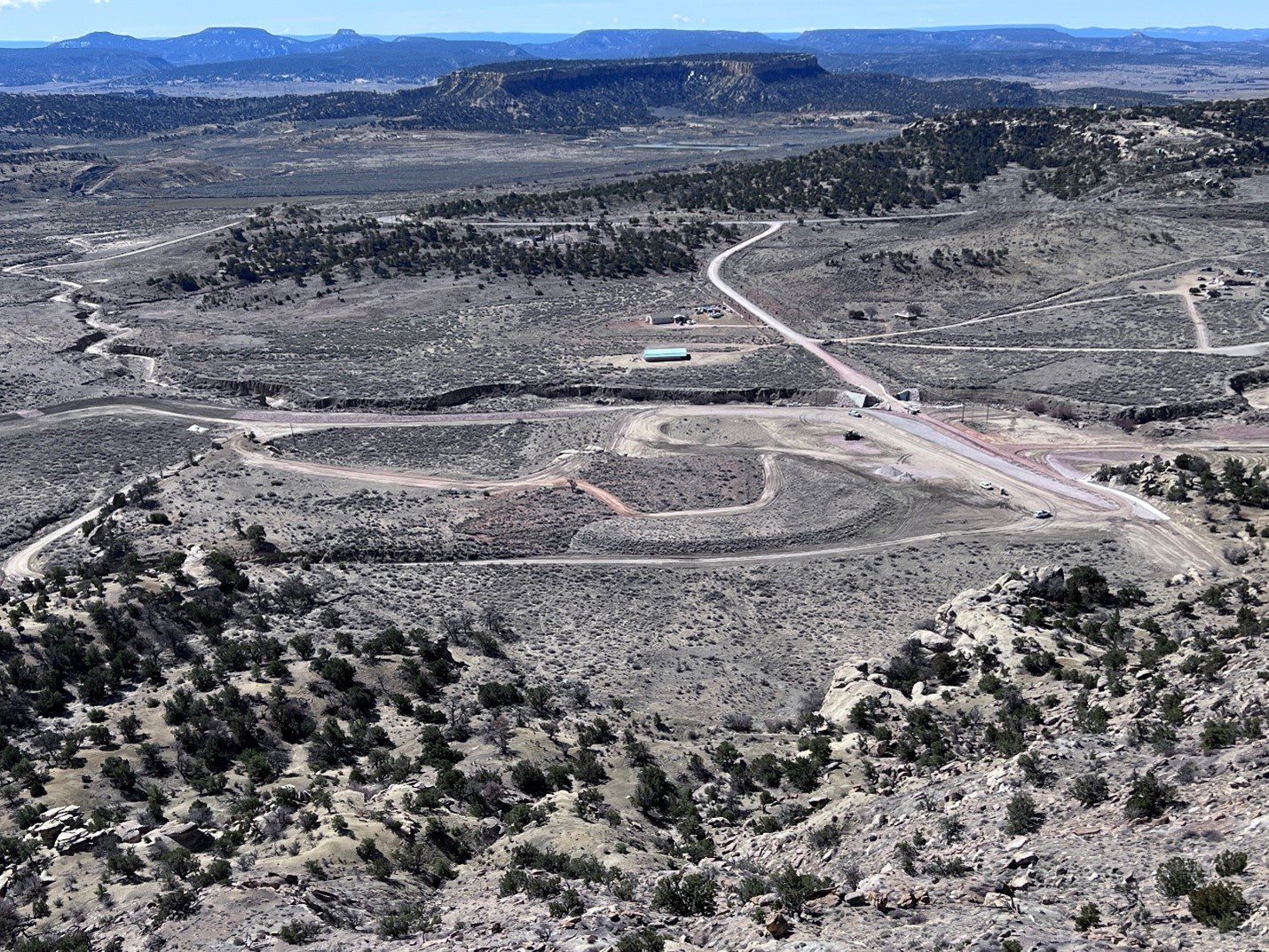- EPA’s decision moves over 1 million cubic yards of waste.
- Nearby Diné communities anticipate health benefits.
- Landfill site east of Thoreau to hold the material long-term.
- Tribal, state, and federal agencies collaborate on the project.
January 14, 2025 — In a landmark move announced last week, communities living near the Churchrock area in northwestern New Mexico received confirmation from the U.S. Environmental Protection Agency (EPA) that more than one million cubic yards of uranium mine waste will be transported from the Quivira Mining Company’s Churchrock Mine to a regional landfill property east of Thoreau. The New Mexico Environmental Law Center and the EPA
and the EPA both issued press releases on January 7, 2025, detailing the specifics of this cleanup plan, which aims to reduce health and environmental risks for local Navajo residents who have lived with uranium contamination for decades.
both issued press releases on January 7, 2025, detailing the specifics of this cleanup plan, which aims to reduce health and environmental risks for local Navajo residents who have lived with uranium contamination for decades.
A Legacy of Uranium Mining.
For over half a century, Navajo communities in Churchrock, part of the Eastern Navajo Agency, have borne the burden of radioactive contamination tied to historic uranium mining. Companies such as Kerr-McGee and Quivira Mining once operated mine shafts that produced ore and discharged mine wastewater, leaving behind low-level radioactive material. Though various partial cleanup efforts have taken place, residents continued to advocate for removing abandoned uranium waste close to their homes and essential resources.
Local groups, including the Red Water Pond Road Community Association (RWPRCA), have pointed to the negative health outcomes of living near unremediated sites. The recent EPA announcement is a significant step forward, confirming the relocation of mine waste to the Red Rock Landfill property, owned by the Northwest New Mexico Regional Solid Waste Authority. By shifting the waste six miles east of Thoreau, proponents say it will help reduce harmful exposure and pave the way for safer community life.
is a significant step forward, confirming the relocation of mine waste to the Red Rock Landfill property, owned by the Northwest New Mexico Regional Solid Waste Authority. By shifting the waste six miles east of Thoreau, proponents say it will help reduce harmful exposure and pave the way for safer community life.
Communities Welcome the Decision.
Grassroots leaders expressed cautious optimism about the plan. According to the January 7, 2025, press release from the New Mexico Environmental Law Center, “I feel as though our community finally has something of a win,” said Teracita Keyanna, a member of the executive committee for RWPRCA . “Removing the mine waste from our community will protect our health and finally put us back on a positive track to Hózhǫ (balance).”
. “Removing the mine waste from our community will protect our health and finally put us back on a positive track to Hózhǫ (balance).”
The choice to relocate the waste has been celebrated by residents of the Red Water Pond Road and Pipeline Road communities, who have long awaited an initiative that could directly diminish their everyday health risks. Keyanna noted, “I think this decision empowers grassroots organizations like ours and our allies continue to advocate and educate to clean up hundreds of abandoned uranium mines that threaten our Diné communities every day.”
Despite the optimistic reception, community advocates acknowledge that this project is only one step in addressing a larger legacy of environmental contamination. Various other sites still require similar attention, and residents and grassroots organizations remain committed to ensuring thorough oversight during every phase of the transfer and disposal.

 , 2007; partially reclaimed abandoned mine in rear. EPA, public domain image.
, 2007; partially reclaimed abandoned mine in rear. EPA, public domain image.EPA’s Plan and the Role of Regulatory Agencies.
The EPA’s selection comes after years of analyzing potential disposal methods for the Quivira Mines site. According to the U.S. Environmental Protection Agency press release on January 7, 2025, Martha Guzman, EPA Pacific Southwest Regional Administrator, stated , “This decision will remove over 1 million cubic yards of waste that has haunted the Red Water Pond Road and Pipeline Road communities for too long.”
, “This decision will remove over 1 million cubic yards of waste that has haunted the Red Water Pond Road and Pipeline Road communities for too long.”
Under the plan, the Northwest New Mexico Regional Solid Waste Authority must obtain permits from the New Mexico Environment Department (NMED) and other state regulators. These permits cover the construction of an engineered disposal cell, long-term monitoring protocols, and bonding that ensures eventual safe closure. James Kenney, Secretary for the New Mexico Environment Departmen t, emphasized the intergovernmental cooperation, calling the project a testament to how federal, tribal, and state agencies can work together to prioritize public health.
t, emphasized the intergovernmental cooperation, calling the project a testament to how federal, tribal, and state agencies can work together to prioritize public health.
Navajo Nation President Buu Nygren , also quoted in the U.S. Environmental Protection Agency press release, described the measure as a compromise that moves radioactive waste off Navajo land as soon as possible. While acknowledging that it may not align perfectly with every community’s ultimate wish, he stressed it as a crucial protective step.
, also quoted in the U.S. Environmental Protection Agency press release, described the measure as a compromise that moves radioactive waste off Navajo land as soon as possible. While acknowledging that it may not align perfectly with every community’s ultimate wish, he stressed it as a crucial protective step.
The Road Ahead.
The EPA plan for the Quivira Mines site spans six to eight years. It involves permitting, constructing the new repository, transporting waste, and eventually sealing off the disposal area to prevent further contamination. Edith Hood, president of RWPRCA , underscored the community’s vigilance: “We are committed to making sure the removal of mine waste from our community does not threaten the health and safety of our Diné neighbors.”
, underscored the community’s vigilance: “We are committed to making sure the removal of mine waste from our community does not threaten the health and safety of our Diné neighbors.”
Public comment periods are expected to accompany the permitting process, allowing residents and other stakeholders to voice questions and concerns. Community members anticipate that these opportunities will help maintain transparency, ensuring all parties remain accountable for meeting the highest safety and environmental standards.
The Red Rock Landfill facility is already a hub for municipal waste from McKinley and Cibola counties and parts of the Navajo Nation. However, this newly designated site for uranium mine waste disposal will likely serve as a model for addressing other abandoned uranium sites across the region. Currently, no dedicated uranium waste disposal facilities exist within 350 miles of the Navajo Nation, meaning the cleanup approach in Churchrock could serve as a precedent for similar projects.
Ultimately, these actions represent a key moment of progress for communities grappling with radioactive contamination for decades. More than a million cubic yards of uranium mine waste will soon be transported away from residential areas—an essential step, advocates say, toward restoring local health, returning balance to the land, and forging a more hopeful path forward for Diné families in the Churchrock area.
~~~
Top Image: 2024 Quivira Mines Former CR-1 Uranium Mine , EPA.
, EPA.




It’s absolutely unforgivable the damage done!!!